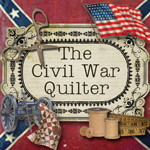Woven coverlets, another example of something I don't collect myself;
but I do like to photograph them when I see them.
This example was also seen at an antique shop in late August of this year.
You can see this lovely woven Jacquard coverlet is "lost" in the jumble on this shelf. What a shame. It is in excellent condition!

I hear rumors that a couple of researchers in the quilt history world may be exploring the cross-over between the patterns seen in Jacquard woven coverlets and the rise in similar patterns in U.S. quilts about the same time. Hopefully an AQSG research paper will appear some day soon! The cross-over seems so natural but who influenced who the most, I wonder?
Joseph Jacquard invented a very sophisticated type of loom that first arrived in the U.S. about 1820. Safford and Bishop, in America's Quilts and Coverlets, state that there were many pattern books for the Jacquard loom so why couldn't quilters have borrowed from those pattern books as well?
I was curious as to why the earlier Double Weave coverlets did not contain a name or date. Safford and Bishop suggest it is because the Jacquard loom could now produce elaborate wide borders and said borders became a distinguishing feature of the large un-seamed coverlets. In contrast, the earlier narrow looms forced forced weavers to create seamed Double Weave coverlets. But with the large border the Jacquard loom could produce, the weaver now had the option of adding something unique in the corner of the border, if he so chose. So why not a name and a date?
Do you suppose this also influenced quilters to name and date their quilts? Or did a weaver see a signed quilt and decide to sign his work as well? Will we ever know which came first?
Franklin D. Sheaffer, whose name appears on this found coverlet, is included in the list of Professional Weavers found on page 277 of the 1972 Safford and Bishop book, America's Quilts and Coverlets.
I couldn't find any example, however, of Sheaffer's work in the book itself. But I did see another coverlet that contains the same outer "leaf"/ring pattern (see page 256). It is dated 1848. (See additional photo details at the end of this post.)
The house border pattern (see detail immediately below) on the the coverlet is similar to but not the same as the one seen on page 267 of the Safford and Bishop book. However, the one in the book is 1856, so much later. It's a very iconic rendition of a house for its time.
Franklin D. Sheaffer is also mentioned on page 211 in American Coverlets and Their Weavers: Coverlets From the Collection of Foster & Muriel Mccarl by Clarita Anderson. Unfortunately, there is no mention of where Sheaffer lived or worked, though we do know that the great majority of this type of coverlet were apparently woven in PA, NY, OH and Indiana. Safford and Bishop also record a few known and identifiable weavers from New Jersey and Michigan.
In the Anderson book it is stated that it is unknown whether Sheaffer was the weaver or the client of the coverlet dated 1849 bearing his name, and, according to Anderson, 1849 is the only date known to carry his name.
As a client, could there be more than one coverlet bearing one's name? Did weavers put the name of a client on every coverlet they made for that individual client? I shall have to check with a few friends who are into woven coverlets to see if they can enlighten me.
Now that I have done this much research today, I wonder if I should have purchased this coverlet! If I had had an iPad with me that day, I could have discovered all this info on-line while still in the antique shop!
Nah, I don't need to start collecting woven coverlets or buttons. No room in my house for more than quilts and books! And not enough money in my budget to to allow the collecting bug to do any more damage!
Enjoy these coverlets wherever you see them, and do take a few minutes to visit the Foster & Muriel Mccarl Gallery now! Just click here.
Cheers!
Karen
PS-1: See a previous post about another woven coverlet I discovered right here in the San Juan Islands.
PS-2: A little footnote in the comparison of patterns:
Did this pattern inspire appliqued wreaths in the 1840s-50s or vice-a-versa? The quilt below was seen in an online auction in September 2011.
Actually, I think this feathered wreath pattern pre-dated both the coverlet and the quilt. When I discover something that contains a similar wreath that pre-dates 1840,
I'll add it to this post.














That is an amazing correlation between appliqued wreaths and feathered borders...
ReplyDeleteWhat wonderful colors in the first woven coverlet and I agree - how sad it was not displayed more appropriately...
Karen, check out this blog about connection between quilts and Welsh blankets:
ReplyDeletehttp://welshquilts.blogspot.com/2011/10/welsh-woven-blankets-at-quilt-museum.html
Thank you, Virginia, for the link. Some have begun to send me more examples so I hope to post more photos soon.
ReplyDeleteThis is so interesting to me when one creative area informs another. :-) Love the crossover!
ReplyDeleteLovely artwork in the woven pieces, especially colors and design.
ReplyDelete